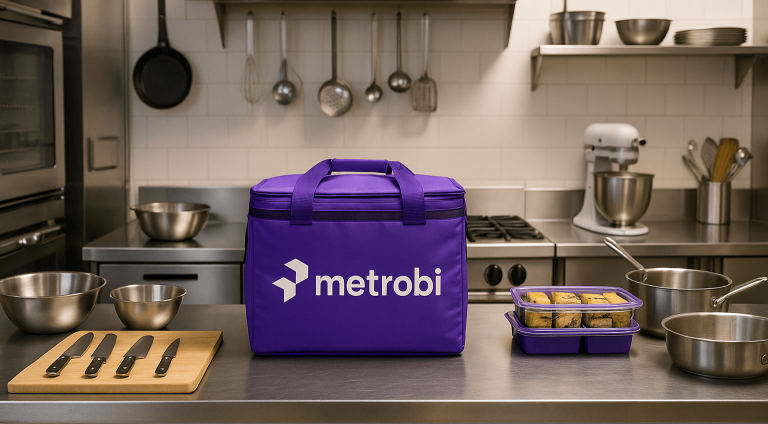Are you opening a restaurant? You’re going to need more than just a killer menu. To keep your kitchen running like a well-oiled machine, you’ll need to invest in the right equipment. Metrobi specializes in streamlining your operations by providing top-tier delivery services for caterers.
But with so many options out there, it can be tough to know where to start. That’s why we’ve put together this list of 27 essential restaurant equipment pieces every business owner needs.
Are you opening a restaurant? You’re going to need more than just a killer menu. To keep your kitchen running like a well-oiled machine, you’ll need to invest in the right equipment. Metrobi specializes in streamlining your operations by providing top-tier delivery services for caterers.
But with so many options out there, it can be tough to know where to start. That’s why we’ve put together this list of 27 essential restaurant equipment pieces every business owner needs.
From high-performance ovens to efficient POS systems, we’ve got you covered. So grab a pen and get ready to take some notes – your restaurant’s success depends on it. Metrobi is here to revolutionize the way your business handles meal delivery, optimizing every step of the service for seamless operations.
The Restaurant Equipment Market
The restaurant equipment market is projected to have a CAGR of 7.9% by 2033, expanding from US$ 4,093.8 million in 2023 to US$ 8,756.63 million by 2033
Lower your delivery costs by 23%
How we reduce costs:
- No delivery vehicle expenses
- Optimized local routes
- Pay-per-delivery model
- Average 23% delivery cost reduction
Essential Commercial Restaurant Equipment for Efficient Food Preparation
When it comes to running a successful restaurant or foodservice operation, having the right restaurant equipment is crucial. Investing in a wide selection of high-quality, efficient tools can streamline your food preparation process, improve consistency, and ultimately enhance the dining experience for your customers. In this section, we’ll explore the most important pieces of equipment every commercial kitchen needs to thrive. Considering pre-owned restaurant equipment for your establishment? Learn about the benefits and potential downsides to ensure you’re making the best choice for your operation.
Cooking Equipment Popularity
Cooking equipment dominates the restaurant equipment market with a 32.6% market share during the forecast period
High-Quality Ranges and Ovens
At the heart of any restaurant kitchen are the ranges and ovens. These workhorses cook various dishes, from sauces and soups to roasted meats and baked goods. When selecting ranges and ovens, consider the following:
Invest in reliable, heavy-duty models for consistent cooking results
Choose the appropriate size and capacity based on your menu and expected volume
Look for features like multiple burners, grills, and convection options to maximize versatility
Importance of Ovens in Restaurant Equipment
Essential for preparing a wide range of menu items from fresh bread to pastries, casseroles, and roasted meats, various designs like convection ovens, combination ovens, pizza ovens, and conveyor ovens are popular in restaurant equipment.
Versatile Food Processors and Blenders
Food processors and blenders are essential for efficiently preparing ingredients and creating smooth, flavorful dishes. High-performance models can save time and labor by quickly chopping, slicing, and mixing ingredients. When choosing food processors and blenders, keep these factors in mind:
Opt for powerful motors that can handle tough ingredients and large batches
Look for models with variable speeds and pulse functions for precise control
Choose designs with easy-to-clean features to simplify maintenance and ensure food safety
Durable Cookware and Bakeware
A well-stocked collection of pots, pans, and baking sheets is essential for any restaurant kitchen. Durable, high-quality cookware and bakeware can withstand the rigors of daily use and help ensure consistent cooking results. When building your collection, consider the following:
Stock up on a variety of sizes to accommodate different dishes and batch sizes
Choose heavy-gauge materials like stainless steel and aluminum for longevity and even heat distribution
Ensure your cookware is compatible with your ranges and ovens to avoid any damage or safety hazards
To determine which pieces of equipment are truly essential for your restaurant, it’s important to evaluate your options based on several key criteria. In the following sections, we’ll take a closer look at each of these factors to help you make informed decisions:
Performance and reliability
Ease of use and maintenance
Versatility and adaptability
Cost and value for money
Brand reputation and customer support
By carefully considering these criteria, you’ll be well-equipped to choose the best kitchen equipment for your restaurant’s unique needs and budget.
The Global Commercial Kitchen Equipment
The global used commercial kitchen equipment market is expected to have a CAGR of 6.1% by 2033, with a market value of US$ 5,763.4 million
Metrobi is transforming catering deliveries
Specialized solutions for catering businesses:
- Catering-trained drivers
- Proper handling equipment
- Peak day delivery support
- 23% average cost reduction
Key Food Storage and Preparation Equipment for Food Safety and Quality
Spacious and Organized Refrigeration Equipment and Units
Investing in high-capacity refrigerators and freezers allows you to store ingredients and prepare items properly, maintaining their quality and freshness. You should consider separate units for raw and cooked foods to prevent cross-contamination, which is a major concern in restaurant kitchens. Ice Machines are also helpful equipment for your business.
It would be best if you looked for refrigeration units with features like adjustable shelving, precise temperature controls, and easy-to-clean surfaces. These features will help you maximize storage space, maintain consistent temperatures, and ensure proper hygiene practices are followed. To keep your ingredients fresh and your kitchen running smoothly, explore the ideal restaurant refrigeration solutions tailored to your needs.
Stainless Steel Prep Tables and Countertops
It is better for businesses to provide ample workspace with stainless steel prep tables and countertops to streamline their kitchen operations. You should choose prep tables with built-in refrigeration for convenient access to ingredients, reducing the need for constant trips to the main refrigerators. This feature can significantly improve kitchen efficiency and workflow.
You can ensure your stainless steel surfaces have proper drainage and backsplashes to prevent water and food debris from accumulating, which can lead to bacterial growth.
By investing in high-quality food storage and preparation equipment, you lay the foundation for a successful and compliant restaurant kitchen. These essential pieces of equipment not only contribute to food safety and quality but also improve efficiency and workflow, ultimately leading to lower prices and a better dining experience.
Popularity of Global Restaurant Equipment For the Hotel Sector
The hotel sector holds a 37.1% market share in the global restaurant equipment industry
Important Safety and Sanitation Equipment for a Healthy Kitchen Environment
Commercial-Grade Dishwashing Equipment
Investing in high-quality, commercial-grade dishwashing equipment is crucial for maintaining a clean and sanitary kitchen. High-capacity dishwashers can handle large volumes of dishes, utensils, and cookware, ensuring they are thoroughly cleaned and sanitized after each use. You can look for models with some features, such as multiple wash cycles, high-temperature sanitizing options, and energy-efficient designs to optimize performance and reduce utility costs.
Proper installation and ventilation are also key considerations when selecting dishwashing equipment. You can ensure that the dishwasher is connected to an appropriate drainage system and that adequate ventilation prevents excess moisture and humidity, which can lead to mold growth and other health hazards.
Essential Fire Safety Equipment
Fire safety is a top priority in any restaurant or commercial kitchen. Installing proper fire suppression systems, extinguishers, and alarms in key areas of the restaurant is essential for preventing and containing fires. You can look for automatic fire suppression systems that are specifically designed for commercial kitchens, as they can quickly detect and extinguish fires in high-risk areas like grease traps and cooking surfaces.
In addition to installation, regular maintenance and inspection of existing fire safety equipment and supplies are crucial for ensuring proper functioning in the event of an emergency. Schedule routine inspections with a certified fire safety professional to check that all equipment is in good working order and up to code.
By investing in the right safety and sanitation equipment in place and prioritizing regular maintenance and staff training, restaurant owners can create a healthy and safe environment for both employees and customers alike.
Importance of Safety Equipment in Restaurant Business
Safety equipment like fire extinguishers, smoke detectors, first aid kits, and PPE is essential for ensuring a safe working environment and complying with regulations in restaurants
Must-Have Front-of-House Equipment for Excellent Customer Experience
Creating an exceptional customer dining experience requires more than just delicious food. The right front-of-house equipment can make a significant difference in how your guests perceive your restaurant. From comfortable seating to efficient point-of-sale systems, investing in key pieces of equipment can help you deliver a seamless and enjoyable experience. Metrobi assists food businesses by managing their delivery operations, offering services across more than 20 cities in the US, including Philadelphia, to ensure an outstanding delivery experience for your customers.
To help you and your clients make informed decisions when selecting front-of-house equipment, we’ve identified the most essential items and outlined the factors to consider for each one. By prioritizing comfort, style, and efficiency, you can create an inviting atmosphere that keeps clients and customers coming back time and time again.
As we dive into the specifics of each piece of equipment, we’ll evaluate them based on the following criteria:
Comfort and durability
Ease of cleaning and maintenance
Compatibility with restaurant theme and ambiance
User-friendliness and efficiency
Cost-effectiveness and return on investment
By carefully considering these factors, you can ensure that your front-of-house equipment not only enhances the customer experience but also streamlines your operations and maximizes your budget. In the following sections, we’ll explore the top seating options and point-of-sale systems available, helping you make the best choice for your restaurant’s unique needs.
Point of Sale Systems
A point of sale (POS) system is the backbone of your restaurant’s operations. It should be user-friendly, efficient, and able to handle various payment methods, including credit cards and mobile payments. Look for a POS system that integrates with other software, such as inventory management and customer relationship management tools, to streamline your operations. Some popular POS systems for restaurants include Oracle Simphony, Lightspeed, and InTouchPOS.
Additional Considerations
When selecting front-of-house equipment, don’t forget to consider the following:
Table Management: A good table management system can help you optimize seating and reduce wait times. You can look for systems that allow you to track table status, manage reservations, and assign servers efficiently.
Self-Service Kiosks: They can help reduce lines and wait times, making them a valuable addition to your front-of-house equipment. You can ensure that your kiosk system integrates with your POS and inventory management systems.
Customer Support: When choosing a POS system or other front-of-house equipment, consider the quality of customer support offered by the provider. You should look for providers with 24/7 support and a reputation for responsive service.
By carefully evaluating these factors and considering the specific needs of your restaurant, you can create a seamless and enjoyable dining experience for your customers. Unlock the key to elevating your dining establishment by uncovering the top supplier for restaurants in your region, thus enhancing your restaurant’s overall success.
Choosing the Right Restaurant Equipment for Your Business
When selecting restaurant equipment, it’s crucial to consider the types of dishes you’ll be preparing and the equipment needed to execute them effectively. Explore where to purchase quality supplies for your restaurant. Ensure your kitchen has everything it needs for smooth operation.
Your service style also plays a significant role in equipment selection. Quick-service restaurants may require more high-volume, fast-cooking equipment, while fine dining establishments may prioritize precision and versatility. Metrobi assists food businesses by offering delivery services across more than 20 cities in the US, including a dedicated courier service in Miami.
Consult with Industry Professionals
Seeking advice from experienced restaurant owners, chefs, and equipment suppliers can help you make informed purchasing decisions. Attend trade shows like the National Restaurant Association Show or the International Pizza Expo to explore the latest equipment options and network with industry professionals.
Reading reviews and comparing features is also essential when evaluating equipment options. Online resources offer extensive product information and customer reviews, which can help guide your decisions,” recommends Brian Warrener, Associate Professor of Hospitality Management at Johnson & Wales University.
By carefully assessing your menu and service style, setting a realistic budget, and consulting with industry professionals, you can select the right restaurant equipment and supplies to support your business’s success.
Equipping Your Restaurant for Success
Investing in the right equipment is crucial for running a top food service operation or successful restaurant. From high-quality ranges and ovens to comfortable seating options and beverage equipment, each piece plays a vital role in creating an efficient kitchen and an excellent customer experience.
As you plan for your restaurant’s future, consider your menu, service style, and growth potential. Set a realistic budget and prioritize investments based on necessity and impact. Don’t hesitate to seek advice from industry professionals and attend trade shows to stay informed about the latest equipment options.














